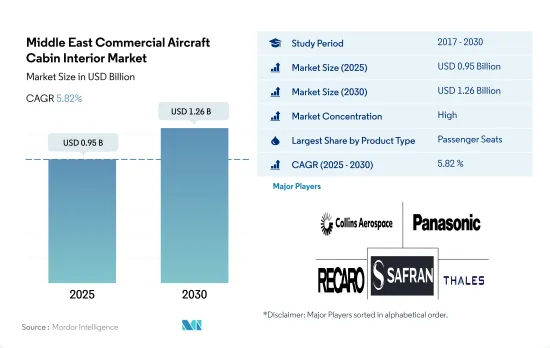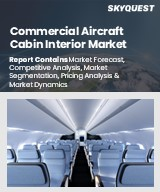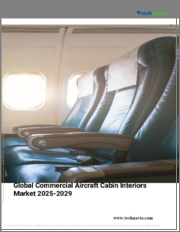
|
시장보고서
상품코드
1693712
중동의 민간 항공기 객실 인테리어 : 시장 점유율 분석, 산업 동향, 통계, 성장 동향 예측(2025-2030년)Middle East Commercial Aircraft Cabin Interior - Market Share Analysis, Industry Trends & Statistics, Growth Forecasts (2025 - 2030) |
||||||
중동의 민간 항공기 객실 인테리어 시장 규모는 2025년에 9억 5,000만 달러, 2030년에는 12억 6,000만 달러에 달할 것으로 예상되며, 예측 기간(2025-2030년) 동안 5.82%의 연평균 복합 성장률(CAGR)을 보일 것으로 예측됩니다.

여객기용 시트가 37.2%로 최대 점유율을 차지
- 중동의 민간 항공기 객실 인테리어 시장은 제품 유형에 따라 좌석, 객실 조명, 기내 엔터테인먼트 시스템, 창문, 갤리 및 화장실, 기타 제품 유형으로 구분됩니다. 이 지역의 항공사들은 승객의 전반적인 편안함과 경험을 향상시키기 위해 이러한 제품의 실용성을 높이는 데 주력하고 있습니다.
- 비즈니스 클래스 이용객 증가로 이코노미 클래스보다 더 넓은 개발 공간을 가진 좌석 구조의 개선이 필수적입니다. 중동의 항공사와 OEM은 2050년 제로 에미션 목표를 고려하여 항공기 경량화 및 항공 산업의 지속 가능한 경영 방식 개발에 대한 노력을 강화하고 있습니다.
- 이 지역의 항공사들은 효율성, 신뢰성, 내구성, 내구성, 무게 측면에서 기존 객실 조명의 다양한 단점을 해결하기 위해 첨단 LED 조명을 채택하고 있습니다. 이처럼 LED 조명 솔루션의 발전에 따라 다양한 OEM들이 기존 객실 조명보다 LED 조명을 채택하고 있습니다. 이 지역의 주요 항공사들은 민간 항공기의 기내 엔터테인먼트 시스템에 4K 기술을 채택하고 있습니다. 항공기 조달이 급증함에 따라 예측 기간 동안 중동 여객 항공 부문은 민간 항공기 객실 인테리어에 대한 수요가 증가할 것으로 예측됩니다.
아랍에미리트 시장은 이 지역에서 가장 높은 성장세를 보일 것으로 예측됩니다.
- 항공사에게 고객 경험은 항상 최우선 순위입니다. 최고의 경험을 제공하기 위해 중동 항공사들은 새롭고 현대화된 객실 인테리어에 주력하고 있으며, 승객들에게 안전하고 쾌적하며 미학적으로 우수한 환경을 제공하기 위해 노력하고 있습니다.
- 항공 승객 수 증가는 새로운 항공기 조달을 촉진하고 객실 인테리어에 대한 수요를 증가시킬 것으로 예측됩니다. 중동 항공사의 2022년 수송량은 2021년 대비 157.4% 증가했습니다. 수송능력은 73.8% 증가했고, 탑승률은 24.6% 상승하여 75.8%에 이르렀으며, 2022년 12월 수요는 2021년 동월 대비 69.8% 증가하였습니다. 아랍에미리트, 사우디아라비아, 카타르 등 주요 국가는 중동 시장 전체 항공 여객 수송량의 55%를 차지합니다. 따라서 이들 국가의 성장은 기타 중동 국가들에 비해 신형 항공기에 대한 높은 수요를 창출할 것으로 예측됩니다.
- 이 지역의 주요 항공사들은 632대의 민간 항공기를 주문했습니다. 이 중 에어아라비아는 A320neo 73대, A321neo 27대, A321XLR 20대, 에미레이트 항공은 A350-900 50대, B777X 115대, B787X 30대, 에티하드 항공은 A321neo 26대, A350-1,000 15대, B777-9형 11대, BB787-9형 21대, 카타르항공은 787-10형 21대, B777-9형 6대, A321XLR 15대, B777-9형 11대, B787-9형 21대, B787-10형 21대, B777-9형 11대, B787-9형 21대 B777-9 11대, BB787-10 21대, 카타르항공은 737Max10 25대, B777-9 40대, B787-10 23대, 플라이두바이는 B737Max8 33대, B737Max9 67대, B737Max10 50대를 주문했습니다.
- 이러한 납품으로 기내 인테리어에 대한 수요가 증가하면서 이 지역의 다양한 항공사들이 LED 기내 조명, 무선 경량 IFES, 편안하고 가벼운 좌석, 기타 기내 제품 등 첨단 항공기 시스템 및 구성품을 선택하고 있습니다.
중동의 민항기 객실 인테리어 시장 동향
항공 여행의 지속적인 성장이 중동의 항공 여객 수송량 증가의 원동력
- 국제 여행 및 무역의 중계지로서 인기가 높은 중동은 비즈니스 및 레저 여행객의 출발지 및 목적지로서도 성장하고 있으며, 2020년 중동의 항공 여객 수송량은 코로나19 팬데믹으로 인한 여행 제한으로 64% 감소했습니다. 그러나 2022년에는 백신 접종률 상승과 휴가철 수요 증가로 인해 이 지역의 항공 여객 수송량은 3억 4,950만 명으로 2021년 대비 16%, 2019년 대비 45% 성장했습니다. 아랍에미리트와 사우디아라비아 등 주요 국가들이 전체 항공 여객 수송량의 42%를 차지하며 기타 중동 국가들에 비해 신형 항공기에 대한 높은 수요를 창출했습니다.
- 2022년 여객 수송능력은 2021년 대비 73.8% 증가했고, 여객 탑승률은 24.6% 증가한 75.8%를 기록했습니다. 이 지역의 항공 여행 회복세는 계속 탄력을 받고 있으며, 항공 여객 수송량은 향후 20년 내에 두 배로 늘어날 것으로 예측됩니다. 바레인, 쿠웨이트, 오만, 사우디아라비아, 아랍에미리트, 이라크, 이란, 요르단, 예멘, 카타르 등 중동의 주요 국제선 노선 중 상당수는 이미 코로나19 이전 수준을 넘어섰습니다. 이는 항공 여행이 회복세를 보이고 있으며, 계속해서 탄력을 받고 있음을 보여줍니다. 중동 내에서도 많은 주요 국제선 노선이 이미 코로나19 이전 수준을 넘어섰습니다. 높은 관광 및 여행 의욕은 중동 및 아프리카의 산업 회복을 지속적으로 촉진하고 있습니다. 항공 여객 수송량은 2022년에 비해 2030년에 34% 증가할 것으로 예측됩니다.
사우디아라비아, 역내에서 가장 높은 1인당 GDP 기록
- 중동의 2022년 GDP는 8조 3,200억 달러로 2021년 대비 21%, 2020년 대비 42% 성장할 것으로 예측됩니다. 지역 전체 GDP 중 사우디아라비아가 2022년 8,330억 달러로 가장 높고, 아랍에미리트 4,090억 달러, 카타르 1,790억 달러가 그 뒤를 잇습니다. 특히 사우디아라비아의 항공운송산업은 202억 달러, 아랍에미리트는 193억 달러가 GDP에 기여하고 있습니다.
- 사우디아라비아는 GDP와 1인당 GDP에서 1위를 차지하고 있으며, 2022년 10월 현재 GDP는 1조 1,000억 달러, 1인당 GDP는 2만 7,940달러를 기록하였습니다. 실적 개선은 석유 부문의 확대에 따른 것으로 2022년 2분기 성장률은 23.1%를 기록했습니다. 비석유 민간 부문의 성장률은 전년 동기 4.5%에서 2022년 2분기 5.4%로 증가했습니다.
- 아랍에미리트(UAE)의 2022년 GDP는 5,039억 1,000만 달러, 1인당 국민소득은 4만 7,790달러를 기록할 것으로 예측됩니다. 탄화수소는 UAE 경제에서 여전히 중요한 역할을 하고 있으며, UAE GDP의 30%는 석유 및 가스 산업, 13%는 수출에 직접적으로 의존하고 있습니다.
- 2022년 카타르의 GDP는 2,213억 7,000만 달러, 1인당 GDP는 6만 8,620달러를 기록했으며, GDP와 1인당 GDP 증가는 주로 카타르의 석유 및 천연가스 자원에 기인한 것으로, 2021년 상반기에는 3,229억 8,000만 달러(2021년 상반기 193억 4,000만 달러)를 기록했습니다. 백만 달러의 수익을 기록했습니다. 대부분의 부문의 이익 증가는 궁극적으로 이 지역의 1인당 GDP를 증가시켜 항공 운송 산업을 견인하고 관련 부문에 대한 수요를 창출할 수 있습니다.
중동의 민항기 객실 인테리어 산업 개요
중동의 민간 항공기 객실 인테리어 시장은 상당히 통합되어 있으며, 상위 5개 기업이 67.35%를 점유하고 있습니다. 이 시장의 주요 기업은 Collins Aerospace, Panasonic Avionics Corporation, Recaro Group, Safran, Thales Group 등입니다.
기타 혜택
- 엑셀 형식 시장 예측(ME) 시트
- 3개월 애널리스트 지원
목차
제1장 주요 요약과 주요 조사 결과
제2장 보고서 오퍼
제3장 서론
- 조사의 전제조건과 시장 정의
- 조사 범위
- 조사 방법
제4장 주요 산업 동향
- 항공 여객 운송량
- 신규 항공기 납입수
- 1인당 GDP(현행 가격)
- 항공기 제조업체의 판매량
- 항공기 수주잔
- 수주 총액
- 공항 건설 지출(지속 중)
- 항공사 연료비
- 규제 프레임워크
- 밸류체인과 유통 채널 분석
제5장 시장 세분화
- 제품 유형
- 캐빈 라이트
- 기내 창문
- 기내 엔터테인먼트 시스템
- 승객 시트
- 기타
- 항공기 유형
- 네로우 보디
- 와이드 보디
- 객실 클래스
- 비즈니스 클래스와 퍼스트 클래스
- 이코노미 클래스와 프리미엄 이코노미 클래스
- 운항국
- 사우디아라비아
- 아랍에미리트(UAE)
- 기타 중동
제6장 경쟁 구도
- 주요 전략적 움직임
- 시장 점유율 분석
- 기업 상황
- 기업 개요
- Adient Aerospace
- Astronics Corporation
- Collins Aerospace
- Diehl Aerospace GmbH
- Expliseat
- FACC AG
- GKN Aerospace Service Limited
- Jamco Corporation
- Luminator Technology Group
- Panasonic Avionics Corporation
- Recaro Group
- Safran
- SCHOTT Technical Glass Solutions GmbH
- STG Aerospace
- Thales Group
제7장 CEO에 대한 주요 전략적 질문
제8장 부록
- 세계 개요
- 개요
- Five Forces 분석 프레임워크
- 세계의 밸류체인 분석
- 시장 역학(DROs)
- 정보원과 참고 문헌
- 도표
- 주요 인사이트
- 데이터 팩
- 용어집
The Middle East Commercial Aircraft Cabin Interior Market size is estimated at 0.95 billion USD in 2025, and is expected to reach 1.26 billion USD by 2030, growing at a CAGR of 5.82% during the forecast period (2025-2030).

Passenger seats accounted for the largest share of 37.2% in the market
- The Middle Eastern commercial aircraft cabin interior market is segmented by product type into seats, cabin lighting, in-flight entertainment systems, windows, galleys and lavatories, and other product types. Airlines in the region are focusing on increasing the utility of these products to improve overall passenger comfort and experience.
- An enhanced seating structure with more developed space than economy-class seats is becoming highly essential due to the rising number of business-class travelers. Middle Eastern airline operators and OEMs are increasing their efforts to reduce aircraft weight and develop a sustainable way to manage the airline industry in consideration of the zero-emission 2050 goal.
- Airlines in the region are adopting advanced LED lighting to eliminate various drawbacks of existing interior cabin lights in terms of efficiency, reliability, durability, and weight. Thus, with the advancement in LED lighting solutions, various OEMs are adopting them over conventional cabin lighting. Major airlines in the region are adopting 4K technology in their in-flight entertainment systems in their active fleet of commercial aircraft. The surging number of aircraft procurements is expected to boost the demand for commercial aircraft cabin interiors in the Middle Eastern passenger aviation sector during the forecast period.
The UAE market is expected to witness the highest growth in the region
- Customer experience is always a top priority for airlines. To provide the best experience, Middle Eastern airlines are focusing on new modernized cabin interiors, providing passengers with a secure, comfortable, and more aesthetically pleasing environment at high altitudes.
- The increase in air passenger traffic is expected to drive new aircraft procurements, thus creating demand for cabin interiors. Middle Eastern airlines registered a 157.4% traffic rise in 2022 compared to 2021. Their capacity increased by 73.8%, while the load factor increased by 24.6% to reach 75.8%. In December 2022, the demand grew by 69.8% compared to the same month in 2021. Major countries, such as the United Arab Emirates, Saudi Arabia, and Qatar, accounted for 55% of the total air passenger traffic in the Middle Eastern market. Hence, growth in these countries is expected to generate a higher demand for new aircraft compared to other Middle Eastern countries.
- Major airlines in the region have registered total orders for 632 commercial aircraft. Of this total, Air Arabia ordered 73 A320neo, 27 A321neo, and 20 A321XLR, Emirates ordered 50 A350-900, 115 B777X, and 30 B787-9, Etihad ordered 26 A321neo, 15 A350-1000, 6 B777-9, 11 B787-9, and 21 BB787-10, Qatar Airways ordered 25 737 Max 10, 40 B777-9, and 23 B787-10, and Flydubai ordered 33 B737 Max 8, 67 B737 Max 9, and 50 B737 Max 10.
- With these deliveries, the demand for cabin interiors has increased, and various airlines in the region are opting for advanced aircraft systems and components such as LED cabin lights, wireless lightweight IFES, comfortable, lightweight seats, and other cabin products.
Middle East Commercial Aircraft Cabin Interior Market Trends
Consistent growth in air travel is the driving factor for air passenger traffic in the Middle East
- The Middle East, a popular connection point for international travelers and trade, is also growing as a starting point and destination for business and leisure passengers. In 2020, air passenger traffic in the Middle East dropped by 64% due to travel restrictions caused by the COVID-19 pandemic. However, in 2022, due to the rising vaccination rates and strong demand over the holiday season, air passenger traffic in the region reached 349.5 million, a growth of 16% compared to 2021, while the growth was at 45% compared to 2019. Major countries, such as the United Arab Emirates and Saudi Arabia, accounted for 42% of the total air passenger traffic, generating higher demand for new aircraft compared to other Middle Eastern countries.
- In 2022, passenger capacity increased by 73.8%, and passenger load factor grew by 24.6% to 75.8% compared to 2021. Air travel recovery in the region continues to gather momentum, and air passenger traffic is expected to double within the next 20 years. Many major Middle Eastern international route areas in Bahrain, Kuwait, Oman, Saudi Arabia, the United Arab Emirates, Iraq, Iran, Jordan, Yemen, and Qatar are already exceeding pre-COVID-19 levels. Such factors indicate that air travel has recovered and continues to gather momentum. Many major international routes, even within the Middle East, are already exceeding pre-COVID-19 levels. Tourism and the high willingness to travel continue to foster the industry's recovery in the Middle East & Africa. The air passenger traffic levels are expected to grow by 34% in 2030 compared to 2022.
Saudi Arabia records the highest GDP per capita in the region
- The Middle East registered a GDP of USD 8,320 billion in 2022, a growth of 21% compared to 2021 and 42% compared to 2020. Of the total region's GDP, Saudi Arabia recorded the highest GDP at USD 833 billion in 2022, followed by the United Arab Emirates at USD 409 billion and Qatar at USD 179 billion. In particular, the air transport industry in Saudi Arabia contributed USD 20.2 billion, whereas the United Arab Emirates contributed USD 19.3 billion to the GDP.
- Saudi Arabia ranks first in terms of GDP and GDP per capita. As of October 2022, the country recorded USD 1.01 trillion in GDP and USD 27.94 thousand in GDP per capita. The improved performance was due to a stronger expansion in the oil sector, which grew by 23.1% in Q2 2022. The growth in the non-oil private sector was 5.4% in Q2 2022, from 4.5% in the previous quarter of the same year.
- The United Arab Emirates recorded a GDP of USD 503.91 billion in 2022 and USD 47.79 thousand per capita. Hydrocarbons continue to play a critical role in the UAE economy, with 30% of the country's GDP directly based on the oil and gas industry and 13% of its exports.
- Qatar recorded USD 221.37 billion in 2022 and USD 68.62 thousand in GDP per capita. The rise in GDP and GDP per capita was primarily due to Qatar's oil and natural gas resources, which recorded a revenue of USD 322.98 billion compared to USD 19.34 billion in the first half of 2021. The rise in profit in most sectors may eventually boost the region's GDP per capita, thereby driving the air transportation industry and creating demand for its associated sectors.
Middle East Commercial Aircraft Cabin Interior Industry Overview
The Middle East Commercial Aircraft Cabin Interior Market is fairly consolidated, with the top five companies occupying 67.35%. The major players in this market are Collins Aerospace, Panasonic Avionics Corporation, Recaro Group, Safran and Thales Group (sorted alphabetically).
Additional Benefits:
- The market estimate (ME) sheet in Excel format
- 3 months of analyst support
TABLE OF CONTENTS
1 EXECUTIVE SUMMARY & KEY FINDINGS
2 REPORT OFFERS
3 INTRODUCTION
- 3.1 Study Assumptions & Market Definition
- 3.2 Scope of the Study
- 3.3 Research Methodology
4 KEY INDUSTRY TRENDS
- 4.1 Air Passenger Traffic
- 4.2 New Aircraft Deliveries
- 4.3 GDP Per Capita (current Price)
- 4.4 Revenue Of Aircraft Manufacturers
- 4.5 Aircraft Backlog
- 4.6 Gross Orders
- 4.7 Expenditure On Airport Construction Projects (ongoing)
- 4.8 Expenditure Of Airlines On Fuel
- 4.9 Regulatory Framework
- 4.10 Value Chain & Distribution Channel Analysis
5 MARKET SEGMENTATION (includes market size in Value in USD, Forecasts up to 2030 and analysis of growth prospects)
- 5.1 Product Type
- 5.1.1 Cabin Lights
- 5.1.2 Cabin Windows
- 5.1.3 In-Flight Entertainment System
- 5.1.4 Passenger Seats
- 5.1.5 Other Product Types
- 5.2 Aircraft Type
- 5.2.1 Narrowbody
- 5.2.2 Widebody
- 5.3 Cabin Class
- 5.3.1 Business and First Class
- 5.3.2 Economy and Premium Economy Class
- 5.4 Country
- 5.4.1 Saudi Arabia
- 5.4.2 United Arab Emirates
- 5.4.3 Rest of Middle East
6 COMPETITIVE LANDSCAPE
- 6.1 Key Strategic Moves
- 6.2 Market Share Analysis
- 6.3 Company Landscape
- 6.4 Company Profiles
- 6.4.1 Adient Aerospace
- 6.4.2 Astronics Corporation
- 6.4.3 Collins Aerospace
- 6.4.4 Diehl Aerospace GmbH
- 6.4.5 Expliseat
- 6.4.6 FACC AG
- 6.4.7 GKN Aerospace Service Limited
- 6.4.8 Jamco Corporation
- 6.4.9 Luminator Technology Group
- 6.4.10 Panasonic Avionics Corporation
- 6.4.11 Recaro Group
- 6.4.12 Safran
- 6.4.13 SCHOTT Technical Glass Solutions GmbH
- 6.4.14 STG Aerospace
- 6.4.15 Thales Group
7 KEY STRATEGIC QUESTIONS FOR COMMERCIAL AIRCRAFT CABIN INTERIOR CEOS
8 APPENDIX
- 8.1 Global Overview
- 8.1.1 Overview
- 8.1.2 Porter's Five Forces Framework
- 8.1.3 Global Value Chain Analysis
- 8.1.4 Market Dynamics (DROs)
- 8.2 Sources & References
- 8.3 List of Tables & Figures
- 8.4 Primary Insights
- 8.5 Data Pack
- 8.6 Glossary of Terms

















